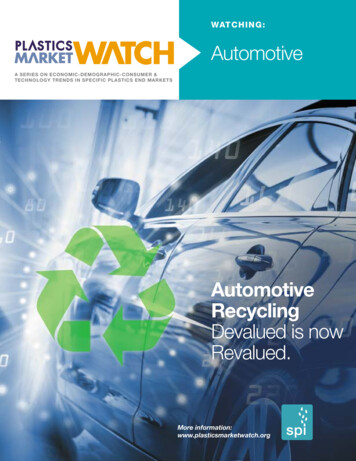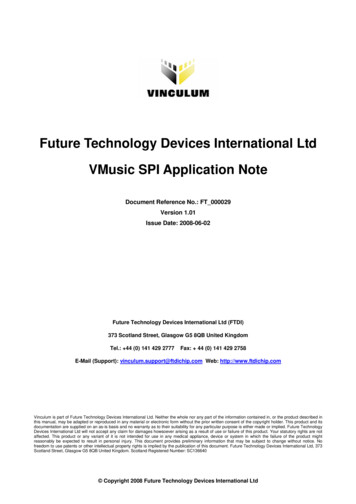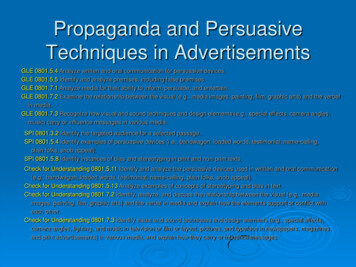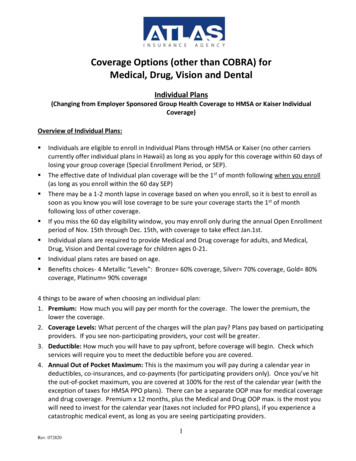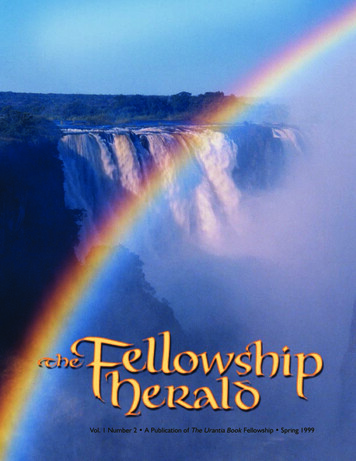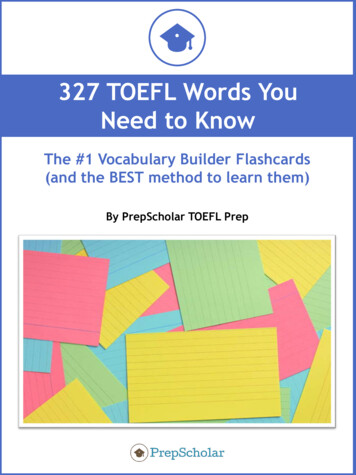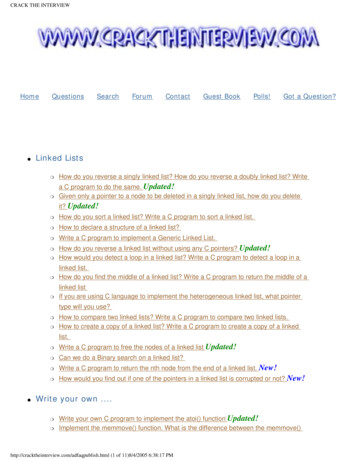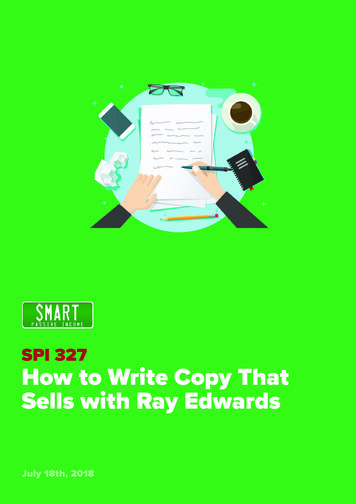
Transcription
SPI 327How to Write Copy ThatSells with Ray EdwardsJuly 18th, 2018
SHOW NOTES: http://www.smartpassiveincome.com/session327Pat Flynn:Sometimes when you’re recording a podcast episode you justknow that the guest you have on, and the subject matter is onethat you’re going to want to give a warning to the audience to interms of, well, you’re going to want to make sure you have a penand paper, or your notepad, or something out. ‘Cause, you’re goingto want to take notes. This is one of those episodes. We’re talkingtoday with Ray Edwards from RayEdwards.com. A fan favorite fromepisode 300, where I brought a bunch of people on. People frommy mastermind group, The Green Room, as it’s also known. But, RayEdwards stood out because he can help you write copy that sells.What is copy, if you’ve never heard that before? That’s the wordsyou write that help people take action. This is if you’re selling anidea, this is if you’re selling a product, if you’re selling a call toaction. It doesn’t really matter. This episode is going to help you.Stick around, cue the music.Announcer:Welcome to the Smart Passive Income Podcast, where it’s all aboutworking hard now so you can sit back and reap the benefits later.And, now your host. His family has a goal to visit every Disney parkin the world, Pat Flynn.Pat Flynn:Oh man, I’m juiced up. I hope you are excited too. If you don’t knowwho I am, my name is Pat Flynn. I’m here to help you make moremoney, save more time, and help more people too. Sometimes wedo that with just me talking about my experiences, and things I doto make things work online. And, other times we bring guests onthe show. Like today’s guest, Ray Edwards from RayEdwards.com.I’ve already introduced him, so let’s just dive right in. Here he is, getready.Ray, welcome back to the Smart Passive Income Podcast. How areyou doing?Ray Edwards:Thank you. You must really like me to have me back.Pat Flynn:And we’re going to have you back again I’m sure, because yourepisode on copywriting back in October of 2015, which was, my1
SHOW NOTES: http://www.smartpassiveincome.com/session327gosh, nearly three years ago. It was a crowd favorite because itgave some very specific strategies and frameworks for creatingcopy that converts. We’re going to talk a little bit more about copytoday, but I would just love to get a quick couple minutes on what’sgoing on in your life. How are things going?Ray Edwards:Things are going great. How else do people answer that question?Does anybody ever say, “Everything sucks right now?”Pat Flynn:You do, you hear that and then you’re like, “I’m sorry. I don’t knowwhat to say next either.”Ray Edwards:“I don’t want to talk to you now.”Pat Flynn:I’m glad things are great. What’s been so great about what’shappening lately? What’s new in Ray Edwards land?Ray Edwards:Well, one thing is that I finally realized the power of having a team. Areal team of employees. We’ve hired what feels like a lot of people.On one hand it feels like a lot of responsibility. I bet you feel someof this, you have team members that you think about the fact that,“Well I’m providing their income.”Pat Flynn:Yeah.Ray Edwards:I mean, they are, they’re working for it. But, ultimately as theentrepreneur I think all of us think from time to time about thepeople who depend on us. The other side of that coin is, theenormous amount of freedom to explore new ideas, to do thingsthat I couldn’t otherwise do because my time is not occupied doingstuff I shouldn’t be doing. It’s not really in my zone of genius.Pat Flynn:Mm-hmm (affirmative).Ray Edwards:I’m not saying I’m a genius, I’m saying we all have a zone of genius.It comes from the book, The Big Leap, by Gay Hendricks. It’s justyour special ability, your, “Unique ability,” as Dan Sullivan would callit. I’m able to stay in that area. I’m kind of surprised and delighted2
SHOW NOTES: http://www.smartpassiveincome.com/session327Pat, at the people who’ve come onboard who are first fans of thework that we’re doing, and they want to be part of that. It feels likewe’re all part of a cause, that we’re all on a mission. It feels less likeI’m hiring people and they’re working quote, “For me.” It’s more likewe’re on a mission together to accomplish something. That’s thegreatest things that’s happening right now. I mean, we’re makinggood money, good revenue. We’ve got some interesting clients thatwe’re working with. That’s all fun, and it’s wonderful. I don’t mean todownplay it. But, this feeling of being on a team is out of this world.Pat Flynn:That’s great. What is the mission that you’re all kind of workingtoward?Ray Edwards:To end poverty.Pat Flynn:That’s a huge mission.Ray Edwards:I mean, I don’t feel like we’re going to do it by ourselves. But, I reallygot clear on this as I began thinking about, you mentioned the book. I think you mentioned the book that I’m writing, or have written.It’s going to be published after the first of the year. It’s called,Permission to Prosper.Pat Flynn:Mm-hmm (affirmative).Ray Edwards:It’s about just that. It’s about having permission to be prosperous,and to understand the ramifications that, that when you prosper,other people prosper. Your prosperity blesses everyone, if you thinkabout it the right way. It doesn’t mean you have to give your moneyaway either. I mean, I know that you’re a benefactor to charities, andI think that’s fantastic. We should all do that as we feel moved to doit. But, I would like people to understand that just doing businesswith integrity is in and of itself, serving humanity and helping toend poverty. The answer to poverty I think is not more governmentprograms, it’s empowering people to create value, and receivevalue in exchange. Which, we often call money.Pat Flynn:Amen to that. Now, you had mentioned an interesting word3
SHOW NOTES: http://www.smartpassiveincome.com/session327there related to prosperity. That’s permission. Why do we needpermission to do this? Don’t we have the ability to do it right nowanyway?Ray Edwards:Well we do, but most of us in Western society at the very least, havebeen trained under the “Judeo-Christian ethic,” quote/unquote. And,really under the puritan ethic. That’s what this country was foundedon. That ethic kind of carried with it some baggage that taught uson the one hand, we should work hard, and be industrious, andbe productive. But on the other hand, it also taught us that moneyis the root of all evil. That’s not even the actual quote. The actualquote is, “The love of money is a root of all kinds of evil.” Meaning,it’s at the root of all sorts of different bad things. But, it’s not the rootof all evil.We have these conflicting inner beliefs that rich people don’t get toheaven, and rich people only get rich by taking advantage of thepoor, and the one percent, because they took stuff away from the99%. None of those things are true. But, if you’re an entrepreneurthink about how difficult it is for you to have those conflictingbeliefs. It’s like you’re driving with one foot on the gas, and one footon the brakes, and that is not good for the car.Pat Flynn:No. That’s a great analogy. I cannot wait to bring you back on theshow to talk about that book. We’re going to help you put it outthere, because it’s very important. You and I, as many people know,are in a mastermind group. Speaking of, I remember the last timeyou were on the show. Well actually, it wasn’t episode 182, it wasepisode 300 when The Green Room was here on the show.Ray Edwards:Yes.Pat Flynn:You were just in a brief moment in that. We talked a little bit aboutyour coffee shop, and some of the other things you were up to.That’s why it feels like it wasn’t that long ago, because it actuallywasn’t that long ago.Ray Edwards:That’s correct.4
SHOW NOTES: http://www.smartpassiveincome.com/session327Pat Flynn:But, you are the featured guest here today. I cannot wait to talk toyou more in the future about that book, and help you push it outthere. But, for today let’s talk about sales copy again. Specifically,copy for sales pages, and kind of what happens when a personlands on that page. We talked, again, a little bit about this in theprevious conversation we had in episode 182, talking about yourPASTOR model. I think, actually let’s start with that. Your framework,just a quick overview of that.That’s actually been really helpful for me in the past couple yearsbecause, I finally now have my own products to sell. But, theinteresting thing I’ve learned after now having my own products,and understanding the PASTOR model, and what kind of goes in theselling process. I’ve taken some of what I’ve learned about sellingmy own products, back into the affiliate marketing world, and sellingother people’s products. From understanding more about theproblems that people are having, which is where the P comes from.And the A, which is my favorite, which is to Amplify that problem.Like, what happens if you don’t take care of this right now? I usedthat now in affiliate marketing, it’s so powerful.Can we do a quick overview of the PASTOR model, that acronym?Then we’ll kind of dive a little bit deeper into sales page specifically,everything from how long does it need to be, and all those technicalthings. Versus, how do we best get people to click on that buybutton. We’ll start with the PASTOR model.Ray Edwards:Okay, so PASTOR is an acronym. It’s P-A-S-T-O-R. I chose the wordpurposely. Not to make you feel like you need to be a preacher,but the original connotation of the word was to shepherd. Theshepherd’s job is to care for the flock, and protect them, and feedthem, and make sure they’re safe from predators. My feeling is, Iwanted to set the stage for us feeling that way about our customers.That, we are shepherding them to a good decision that’s in theirbest interest. Not, that we’re trying to twist their arm, or manipulatethem, or mind voodoo them into buying something they don’t need.With that heart space that we’re coming from, then we go through5
SHOW NOTES: http://www.smartpassiveincome.com/session327the letters of the word PASTOR for our framework for copy. It startswith the Person, the Problem, and the Pain. The person obviously isall about knowing your customer really well inside out. That takeswork, it takes actually getting to know them. People ask me, “Wellhow do I get to know my customer?” Well, how do you get to knowanybody? You spend time with them, you talk to them, you listen tothem more important. Then the problem that you’re helping solve.You need to understand the nature of that, and it needs to be theproblem as they perceive it, and the pain as they perceive it.One of the examples I like to give is, if you’re selling a weightloss solution, you may think the problem is they’re overweight, sothey’re unhealthy, and they’re at risk for cardiovascular disease, anddiabetes, and a host of other problems. But, that’s not what they’refeeling. What they’re feeling is, they are unhappy with the way theylook. They look in the mirror, they think to themselves, “I’m fat. I lookdisgusting. I don’t want to go out in public. I don’t want to date. Idon’t want to go to the swimming pool. I don’t want to take off myshirt. I really feel bad about the way I look. I’m ashamed.” That’s atthe core of what they’re feeling.So, understanding the pain as they’re experiencing it is somethingpeople miss a lot.Pat Flynn:Mm-hmm (affirmative).Ray Edwards:Then Amplifying that pain, as you just mentioned. Amplifying theconsequences of not solving the problem. What’s going to happenif you don’t take care of this? Well, let me tell you. This is what thefuture is going to look like. I’ve seen it a thousand times. You’veseen it yourself. Ask yourself, “Isn’t this true? This is what’s going tohappen.” You walk them through that. When you can get them tothe place where they really see their future, having not solved theproblem, most people are ready to buy at that point. We continueon and tell them the story of how we arrived at the solution. Often,there’s a story of struggle, and finding the solution, then systemizingthe knowledge. I mean, your story, your journey is a classic examplethat you had a problem. You were out of work, you looked for a6
SHOW NOTES: on, you decided to create this passive income model of doingbusiness, you created these niche sites. You solved that problem,and you’ve created systems that other people could follow. That’sthe classic storyline. It’s really the heroes journey.All stories are the heroes journey. Then, T is for Testimony andTransformation. These are people talking about how they’veused your product, how they’ve used your affiliate training, orwhatever you happen to be offering. Or, how they’ve used theaffiliate products that you talked them into buying, and how they’vebenefited from it. They’re giving their testimonial saying, “That wasa great idea. I mean, Pat recommending to me to get BlueHost asmy hosting company, has been the best decision I’ve ever made.I had problems, BlueHost came in and helped me.” Those aretestimonials.Then, there’s the Offer, which is people think it’s about, “Well, thisis the thing you get. It’s a box of stuff, it costs 100.” That’s not theoffer. That’s a description of the cost of the offer. The offer is reallyabout the transformation. Like, the peace of mind you’re going toget from having a good solid hosting company. Or, the peace ofmind you’re going to get from having passive income rolling in, andyou don’t have to worry about starting the money at zero everymonth. You’ve got income starting before the month even beginsthat you can count on.Then the R is they’re Requesting your response. That’s the buybutton. It’s asking people to buy saying, “This is what you do now toget the thing I just told you about.” That’s PASTOR.Pat Flynn:I love that. I wasn’t sure if there was an S at the end for the longesttime, until I picked up your book again, Copy That Sells. Which, isalso a great book. We’ll have all these resources in the resourcesection obviously, in the show notes. But I thought maybe therewas an S in there for something like Scarcity. I’d love for you totalk about this a little bit before we get into more of the weeds ofthe sales page. The purpose of it, I had a lot of sort of demons inmy head related to injecting scarcity into offers, especially with7
SHOW NOTES: ing like a digital product. Which, “Well yeah, you say there’sonly 100 spots.” But, for real, it’s like a digital product. You can sellas many as you want.Ray Edwards:Yeah.Pat Flynn:I was like, that kind of thinking, especially for my audience herelistening. A lot of them have online courses, eBooks. Scarcity isn’tsomething that comes easy unless you literally say, “I’m just, I don’thave enough of them to give away.” Which, is not really possible fordigital products. Is scarcity important? If so, how do we inject it intothis whole process?Ray Edwards:Well, I think urgency is important. That may or may not involvescarcity.Pat Flynn:Ah, okay. I like that.Ray Edwards:How do we make it urgent? Well, if it’s a digital product it makes nosense to say, “We only have 100 of these, so you better buy now.”Everybody knows that’s bologna. Even if everybody didn’t knowit, you would know it, and that would be enough to stop you. But,what can be true is, you may have limited enrollment windows. Ifyou’re doing a live sort of, semi live coaching program where youhave prerecorded trainings, and then each week you do coachingcalls where you’re live interacting with people. You can legitimatelysay, if this is how you do it. “For 10 weeks we’re going to have thesecoaching calls that go along with the program. So, we open it uplike a university college course, and we close registration beforeclass begins so we can concentrate on the students that we havejust brought into the program.”That introduces urgency. Like, “I have to enroll by Friday or they’regoing to close the doors. I won’t be able to enroll again for a year,or six months,” or whatever the time period is.Pat Flynn:Mm-hmm (affirmative).8
SHOW NOTES: http://www.smartpassiveincome.com/session327Ray Edwards:That’s not false scarcity, which I hate false scarcity. I really thinkpeople should understand that most people are not going to fall forthat anymore. It’s just a, just don’t do it. There’s one form of urgencyand scarcity that people don’t talk about enough. I think that’sthe underlining and illustrating the cost of not buying what you’reoffering. That may sound like amplifying the problem, but there’san element of urgency in that every day you wait, is a day you livewithout the solution. If your solution helps business owners makeextra revenue for their business for instance, and you can get themto figure out what that number is. I may say, “Well gosh Pat, if I usedyour method to run my online store, I’d probably make an extra 10,000 a month that I’m not making right now.”Well, it’s easy for you to then say, “So, multiply that 10,000 times12. That gives you 120,000. That’s what it’s costing you to not solvethis problem with this solution that I have. The question isn’t reallywhether you want to buy this. The question is, how many years doyou want to keep paying 120,000 for having this problem?” Thatintroduces urgency because every day I delay is money lost.Pat Flynn:Wow. I like that a lot. Thank you Ray. What about cost or pricefluctuation urgency? “Price will go up soon.” Or, “This coupon isonly available for this amount of time.” I kind of hover back and forthbetween, “Yeah, you know. Increasing and decreasing the price is agreat strategy in some cases.” Other times I’m like, “No, I don’t wantto train my audience that discounts are normal. I don’t want to be aJC Penney.” How do you balance that?Ray Edwards:Yeah. I think a lot of it depends on how you feel about it personally.Pat Flynn:Mm-hmm (affirmative).Ray Edwards:But, I do some of that. We don’t do discounts, but we do the priceis increasing at a certain date. But, there’s one thing I always do. Ifeel like that’s usually so arbitrary. That, my response as a consumeris, “Why? Why is it Friday at midnight that it changes?” I just tellthem the truth. I say, “Look, you may be asking yourself, ‘why Fridayat midnight? That seems arbitrary.’ Well, it is. Except, my job is to9
SHOW NOTES: te you to do what’s in your best interest. I believe getting thisproduct is in your best interest. I know if I put a deadline on it, you’lltake it more seriously. That’s why we’ve engineered it so that theprice goes up at midnight on Friday. I’m trying to motivate you tomake a decision.”Nobody feels icky about that, because you’ve been totally aboveboard with why you’re doing this.Pat Flynn:Yeah. I mean you’re literally telling them the strategy.Ray Edwards:Yeah, yeah.Pat Flynn:So, PASTORU. You’ve included Urgency there. Not quite as niceas PASTORS. But, I’ll take it. I like urgency versus scarcity. I thinkthat’s a good overview. Now, does that give us the framework for asales page? Do we literally go three P’s, A-S-T-O-R, and perhaps Ukind of is involved in there somewhere as well? Or, is a sales pagespecifically the page on a website that sells our product. Is thatstructured differently than this?Ray Edwards:I start with the framework, the PASTOR framework.Pat Flynn:Mm-hmm (affirmative).Ray Edwards:I mean, I literally open a document and type the words, P-A-S-T-O-Rdown the side of the document, and start building my paragraphs.To me it’s the overarching framework of any persuasive message.And, there are other elements that are not mentioned in thePASTOR framework that needed to be included. Like, authority, orcredibility pieces. But, you could say that falls under testimonial, soit’s a kind of proof.Pat Flynn:Mm-hmm (affirmative).Ray Edwards:There are bullet points. We don’t talk about bullet points in thePASTOR framework. But, bullet points are very important. What’sinteresting to me is, I, in my course. I have a, I think its’ 15 elements10
SHOW NOTES: http://www.smartpassiveincome.com/session327of a winning sales letter. It’s also in my book. If you don’t want to getmy course, you can get my book for like seven bucks on Amazon.I’ve seen a lot of changes in this area right now, Pat. I used to tellpeople, “Long copy always wins.” In fact, I think I’ve told you that.Pat Flynn:Mm-hmm (affirmative).Ray Edwards:It doesn’t always win anymore. It often wins. It’s often what’srequired. But, today’s audiences are more sophisticated than everbefore, and it’s more important than ever before that we learn tospeak to them in their language. I think your audience for instance,has a much different lingo and vibe than some other onlinebusiness expert’s audiences might have. Your approach might notwork so well with them. But, for your audience, if you tried to dothe things that they do, these other people who sell how to be inbusiness online stuff, it would fall flat.The sensitivity to how to deliver the sales page message is veryimportant. That often means, like I think you have a certain styleon your website. It is, I would describe it as hip, cool, lots of whitespace, punchy, to the point, direct without being harsh. So, yoursales pages need to be the same way, and they are from what I’veseen. They’re very much that way. They include all the pieces of thePASTOR framework, and they include all the components. There’stwo things happening here. There’s the overarching frameworkof the copy, PASTOR. Then there’s the components of how youconstruct the whole thing.That gets into headlines, and sub headlines, and bullet points, andcall out boxes, and some of that is more design.Pat Flynn:Yeah.Ray Edwards:But, it’s part of the overall thing that happens to people when theycome to make the sales decision.Pat Flynn:When it comes to the headline, which is I would assume the first11
SHOW NOTES: http://www.smartpassiveincome.com/session327thing people see and read when they’re on a page. This is at thetop, the bold words. What are some of the biggest mistakes thatwe’re all making that we should avoid? In other words, what shouldwe be doing with the headline? There’s so many . When you’ve gotthe framework but then you’ve got to start actually putting pen topaper, or start typing. I mean, sometimes that headline is just, that’swhat stops people.Ray Edwards:Yeah.Pat Flynn:That, like, the typical advice would be, “Okay, worry about theheadline later. Get all the other things filled out.” I mean, it just oftenstops people in their tracks. What could we do to approach theheadline in a more fascinating, and more interesting way that wecould actually get it done without stopping?Ray Edwards:I often give the advice that you should write the headline last, afteryou write a whole bunch of bullet points. But, I usually also tell thewhole story. The whole story is, the best headlines I’ve written areones where I wrote the headline before I wrote anything else. Itusually comes out of, I’m doing research, I’m reading other people’scopy about similar products, I’m reading my own copy that I’vewritten so far about my product, I’m reading about my market. I’mlooking at books that relate to the subject matter. And, when youthrow all of that thought, those ideas into your subconscious, itbegins to mix those things up. I think there comes a convergencepoint where you start having some original ideas.For a recent workshop we did, I asked myself, “What is the truestthing about my business right now that people are fascinated with,that they’d like to learn in a workshop?” The truest thing is, howdid you get to a million dollars in revenue as a writer, and you’renot a best seller? You’re not Stephen King, or something like that.As I was thinking about this, I was journaling about it one dayand I wrote down, “Courage.” I realized, “Well it takes courage toget there because there’s all kinds of psychological baggage.” Idon’t need to unpack all that for you right now. But, that was theoverwhelming feeling I had. My headline for that copy was, “Do You12
SHOW NOTES: http://www.smartpassiveincome.com/session327Have the Courage to Become a Million Dollar Writer?”That resonated with me, and so I sat down and banged out the restof that copy in an afternoon. It’s been some of the most successfulcopy I’ve written. We’ve sold that workshop out twice now, at 10,000 a ticket. 12 attendees at each event, and it sells out fast. It’snot available now, so I’m not trying to pitch that. But, I’m trying tosay, the inspiration factor when you get a headline that makes yourbell ring you think, “That’s it.” My encouragement to you is run withthat, and pour out your copy while you’re in that state. ‘Cause whenyou’re in that excited state, and that seems like a brilliant idea toyou, that has a half life. It only lasts so long.Pat Flynn:Mm-hmm (affirmative).Ray Edwards:If you wait, it’ll go away. Your brain will start killing the idea.Pat Flynn:Your headline there was a question. Is a question a great way to .Ray Edwards:It’s a terrible idea. I tell people not to do that. Because, it’s likewhen they train you to be an attorney, they teach you, “Don’t everask a question in court that you’re not certain you know what theanswer’s going to be. And for heavens sakes, never ask a yes or noquestion.” Well, my question violates both those things. So, what doyou do with that?Writing copy is part science, and a large part art. I used to hesitateto say that, because it makes it sound elitist. But it’s not, I thinkeverybody has the creative side within them. But, one thing that. The biggest distinction I made in the last year is that 80% of thesales copy process is about connection. Emotional connection withyour audience, 80%. I’d say 15% is about facts and information. And,so that leaves by my math, five percent. I’d say three percent of thatis the offer, and two percent is whatever urgency you have aboutthe offer.If you look at that scale, I mean 80% connection. That’s knowingyour market, knowing their needs, knowing their pain, knowing13
SHOW NOTES: http://www.smartpassiveincome.com/session327their desires, what keeps them awake at night, knowing how to talkabout it, being able to describe it better than they can describe itthemselves. When you can do that, as Jay Abraham said, “They feellike you already have the answer.” You must, you know the problemso well.Pat Flynn:Those who are struggling with how to connect emotionally withtheir customers, or their prospects. If you were working withsomebody, let’s say somebody hires you, Ray, for copywriting. Whatare some questions that you might ask them to help them tell thatstory?Ray Edwards:Well, if I was working with somebody who was having troubleconnecting emotionally with their customers, I would sit downin their office and I would say, “Okay. Do you have some phonenumbers of some customers? Let’s call them.” I would want to talkto the customers, and record those conversations. And, try to getcustomers who are happy, and also customers who are not happywith what they’ve bought from you in the past, or with their status asit relates to the problem that they experienced, which caused themto buy it to begin with. And, let them do most of the talking.A better way to do this is to throw some kind of open house, andjust have people listening carefully for phrases that come out of thelips of your customers, and paying attention. There’s nothing thatwill connect you to customers like being with them in person.Pat Flynn:Mm-hmm (affirmative).Ray Edwards:No survey, no demographic data, no psychographic data. Noneof that will work as well as being with them in person. The nextpiece of advice I would give to that person is, if you feel like youknow quite a bit about your customer, I would encourage you todo something called the, “Instant empathy exercise.” That doesn’tsound like hype at all, does it?Sit down, close your eyes. Imagine yourself living through thecustomers day. Your perfect customer. If you have an ideal perfect14
SHOW NOTES: er, or avatar as some people call it. Imagine you’re them,and you wake up in the morning. I mean, go into this in vivid detail.Imagine what kind of smells you smell, what kinds of sounds youhear, who’s in the bed with you. Is the dog in the bed, is the dogon the floor, do you have a dog, do you hate dogs? Is the bedroommessy or neat? Is it beautiful or shabby? What’s the first thing youdo when you get up? Well, after you do that. Then do you brushyour teeth? What do you have for breakfast? What kind of carddo you get in? Is the house noisy when you leave? Is it chaotic, isit peaceful and tranquil? What route do you take to work? Do youhate your boss when you get there? Are you the boss when you getthere? Do you still hate the boss when you get there?Go, and try to come up with every smell, sight, sound, sensation,emotion. Just, build this huge imaginary day all the way until theyget home and go to bed. If you’ve done the exercise, and you’vedone it well. You’ve done it with your eyes closed, you’ve imaginedit vividly, you’ve gone overboard, you’ve exaggerated. Maybeit’s silly in places sometimes, and you open your eyes and youimmediately start writing your copy.I don’t know why this works, but it’s like you became a tuning forkthat’s tuned to your customer. Things will come out of you, I don’tmean to sound too spooky. But, things will come out of you thatyou didn’t know you had inside of you. Those are the things that’llconnect with your customer like nothing else. They’ll have thereaction, “It’s like he’s been reading my mind.” Or, “That’s exactlyhow I feel, but nobody’s been able to put it into words before.”That’s what doing that exercise will do for you.Pat Flynn:The instant empathy exercise. I like that.Ray Edwards:Yeah.Pat Flynn:That’ll be a
Edwards stood out because he can help you write copy that sells. What is copy, if you've never heard that before? That's the words you write that help people take action. This is if you're selling an idea, this is if you're selling a product, if you're selling a call to action. It doesn't really matter. This episode is going to help .

